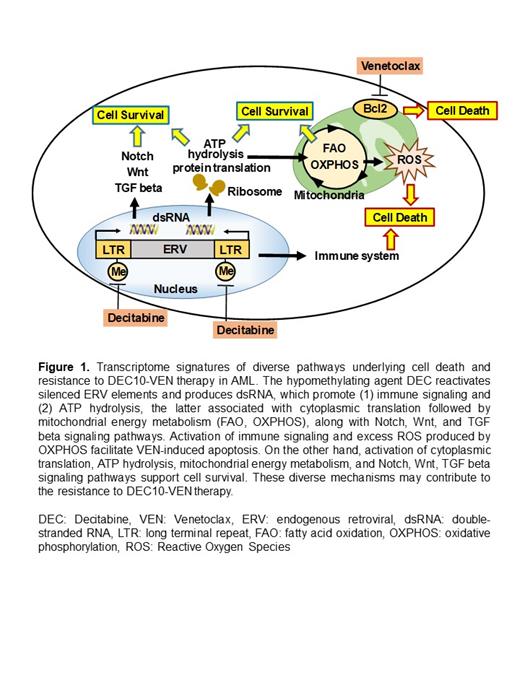Abstract
A selective BCL-2 inhibitor venetoclax synergizes with hypomethylating agents (HMA). Combination of venetoclax plus HMAs (decitabine or azacitidine) is FDA approved for the treatment of high-risk newly-diagnosed (ND) AML including older patients and patients unfit intensive chemotherapy.
We have reported that combination of venetoclax with ten-day HMA decitabine (DEC10-VEN, NCT03404193) demonstrated high efficacy in ND AML patients, with lower overall response rates in relapsed/refractory (R/R) AML. Specifically, the complete remission (CR/CRi) rates were 84% in ND AML and 42% in R/R AML (DiNardo et al. Lancet Haematol. 2020). The determinants of reduced efficacy in the R/R compared to ND AML are not defined.
To characterize the transcriptomic signatures associated with response or resistance to DEC10-VEN in ND vs R/R AML, we performed RNA-seq analysis on samples from genetically diverse 24 AML patients treated on DEC10-VEN clinical trial. The pre-treatment samples from 11 ND patients, including 6 patients who achieved CR/CRi and 5 who failed to respond or subsequently relapsed (non-responders, NR); and from 9 R/R patients, 3 patients who achieved CR/CRi and 6 NR, have been analyzed with a NovaSeq 6000 platform.
We first performed the comparative analysis of NR vs CR/CRi cases using pre-treatment samples. In ND AML patients 113 genes were higher and 62 genes were lower, and in R/R group 33 genes were higher and 69 genes were lower, in non-responders than in CR/CRi patients (log fold-change >|2|, FDR < 0.05). In ND AML, the top functional processes identified by Gene Ontology (GO) analysis (FDR < 0.05) in non-responders were genes involved in oxidative phosphorylation (OXPHOS) and cell migration/adhesion, such as upregulation of OXPHOS/energy metabolism-associated genes MT-CO3, COX6B2, NADK and cell-to-cell interactions mediator TSHBS1. In contrast, R/R AML patients that failed to achieve the response had lower transcriptomic signatures of genes associated with immune system such as TLR8, FCER2, TNFAIP3, CCR7, compared to responders.
Recently, HMAs have been reported to activate silenced endogenous retroviral (ERV) elements regulated by epigenetic modifications, followed by upregulation of interferon-response genes and activation of energy metabolism through ATP hydrolysis (Fresquet et al. Cancer Discovery, 2021). ERVs re-activation may have dual opposing role in malignant cells including leukemia: (1) inducing "immunogenic cell death" by mounting innate antiviral immune responses; and (2) promoting carcinogenesis through activation of Notch signaling and fostering tumor cell proliferation with energy consumption. We analyzed transcription of 45 well-annotated ERV in 9 samples of 6 pre- and 3 post- DEC10-VEN treatment in R/R AML patients who failed to respond. The differential expression analysis with the custom-built ERV reference genome by STAR demonstrated ERVFRD, HERVK-27 and ERVK3-1 as significantly upregulated after DEC10-VEN treatment. Of note, HERV-K27 is one of human cancer-associated HERV-K proviruses. GO analysis demonstrated that these 3 ERVs are positively associated with innate immune system, Notch, Wnt, TGF beta signaling pathways and fatty acid oxidation. To further determine the potential function of ERVs, we investigated the upregulated genes after DEC10-VEN treatment in R/R AML that failed to respond. The top 10 significantly upregulated GO terms were dominated by immune response and cytoplasmic translation, associated with upregulation of ATP hydrolysis activating gene TNNT1, interferon simulated gene TNFAIP3, Notch1 regulating CAMK2A, TGF beta regulating SMAD7, and endogenous RNA MUEOV that promotes tumor metastasis through TGF beta signaling.
Taken together, our transcriptomic analysis suggests that diverse pathways may contribute to the development of resistance to DEC10-VEN in AML cells in ND and R/R patients. In ND patients, high OXPHOS and microenvironment confer resistance to therapy. In R/R AML, baseline immune suppression is aided by the ERVs reactivation by DEC10-VEN therapy, which in turn may promote ATP consumption, energy metabolism, and Notch signaling (Figure 1). These findings are currently being validated and may identify novel mechanisms of resistance to DEC10-VEN treatment in ND and R/R AML.
DiNardo: Foghorn: Honoraria, Research Funding; GlaxoSmithKline: Membership on an entity's Board of Directors or advisory committees; ImmuneOnc: Honoraria, Research Funding; Forma: Honoraria, Research Funding; AbbVie: Consultancy, Research Funding; Agios/Servier: Consultancy, Honoraria, Research Funding; Celgene, a Bristol Myers Squibb company: Honoraria, Research Funding; Bristol Myers Squibb: Honoraria, Research Funding; Takeda: Honoraria; Notable Labs: Current holder of stock options in a privately-held company, Membership on an entity's Board of Directors or advisory committees; Novartis: Honoraria. Konopleva: Ablynx: Other: grant support, Research Funding; Stemline Therapeutics: Research Funding; AstraZeneca: Other: grant support, Research Funding; Genentech: Consultancy, Honoraria, Other: grant support, Research Funding; Cellectis: Other: grant support; KisoJi: Research Funding; Calithera: Other: grant support, Research Funding; AbbVie: Consultancy, Honoraria, Other: Grant Support, Research Funding; Eli Lilly: Patents & Royalties: intellectual property rights, Research Funding; Rafael Pharmaceuticals: Other: grant support, Research Funding; F. Hoffmann-La Roche: Consultancy, Honoraria, Other: grant support; Forty Seven: Other: grant support, Research Funding; Ascentage: Other: grant support, Research Funding; Agios: Other: grant support, Research Funding; Sanofi: Other: grant support, Research Funding; Novartis: Other: research funding pending, Patents & Royalties: intellectual property rights; Reata Pharmaceuticals: Current holder of stock options in a privately-held company, Patents & Royalties: intellectual property rights.


This feature is available to Subscribers Only
Sign In or Create an Account Close Modal